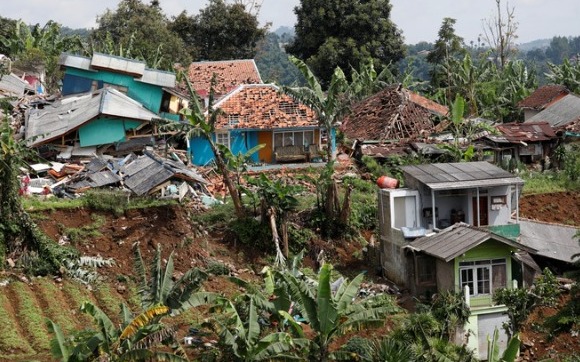Cianjur (Indonesia): More rescuers and volunteers were deployed on Wednesday in devastated areas on Indonesia’s main island of Java to search for the dead and missing from an earthquake that killed at least 271 people.
With many missing, some remote areas still unreachable and more than 2,000 people injured in the 5.6 magnitude quake on Monday, the death toll was likely to rise.
Hospitals near the epicentre on the densely populated island were already overwhelmed, and patients hooked up to IV drips lay on stretchers and cots in tents set up outside, awaiting further treatment.
More than 12,000 army personnel were deployed on Wednesday to increase the strength of search efforts that being carried out by more than 2,000 joint forces of police, the search and rescue agency and volunteers, said Suharyanto, the National Disaster Mitigation Agency chief.
Suharyanto, who like many Indonesians uses only one name, said aid was reaching thousands of people left homeless who fled to temporary shelters where supplies can be distributed only by foot over the rough terrain.
He said rescuers recovered three bodies Wednesday and rescued a 6-year-old boy who was found alive next to the dead body of his grandmother after spending two days trapped under the rubble of his collapsed house.
Television reports showed police, soldiers and other rescue personnel using jackhammers, circular saws and sometimes their bare hands and farm tools, digging desperately in the worst-hit area of Cijendil village where tons of mud, rocks and trees were left from a landslide.
The government appeared to be focused on finding bodies, and wherever possible, survivors. Authorities struggled to bring tractors and other heavy equipment over washed-out roads after earthquake triggered landslides crashing onto the hilly hamlets.
But still, residents said the government was slow to respond to the earthquake.
Muhammad Tohir, 48, was sitting in his living room with family in Cijendil when the catastrophe struck. Although his family managed to make it out, his sister and her two children was crushed by a landslide, a few kilometres (miles) of his house.
“When I came to my sister’s house, I was devastated by what I saw,” Tohir said. “Dozens of houses had been buried by landslides. … I feel like doomsday.” He said more than 40 houses in his sister’s neighbourhood in Cijendil were buried under tons of mud with at least 45 people were buried alive, including Tohir’s sister and her two children.
Tohir, along with other residents in the area, searched for the missing using farm tools and managed to pull out two bodies buried under as much as 6 metres (10 feet) of mud. Two days later, rescue personnel arrived to help in the search.
“The government too slow to respond to this disaster,” Tohir said. “They should be bringing in heavy equipment to speed this up,” he said.
But he said that he will not give up until they can pull his sister and his nieces out of the mud.
In several hard-hit areas, water, food and medical supplies were being distributed from trucks, and authorities have deployed military personnel carrying food, medicine, blankets, field tents and water tankers.
Volunteers and rescue personnel erected more temporary shelters for those left homeless in several villages of Cianjur district.
About 800 police, soldiers and volunteers dug through the debris with their bare hands, shovels and hoes as heavy rain hindered their efforts.
Arif Yulianto, a search and rescue operation coordinator said the search effort was halted Wednesday afternoon due to heavy rains that made the landslide areas unstable. The operation is to be resumed early Thursday.
Most were barely protected by makeshift shelters that were lashed by heavy monsoon downpours. Only a few were lucky to be protected by tarpaulin-covered tents. They said they were running low on food, blankets and other aid, as emergency supplies were rushed to the region.
Suharyanto said more than 58,000 survivors were moved to shelters and 2,043 people were injured, with nearly 600 of them still receiving treatment for serious injuries.
He said rescuers had recovered bodies from collapsed houses and from landslides that were triggered by the earthquake, and about 40 people were still missing. But not all of the 271 dead have been identified, so it’s possible some the bodies pulled from the rubble are of people on the missing list.
Rescue operations were focused on about a dozen villages in Cianjur, where people are still believed trapped, Suharyanto said.
In a news conference on Wednesday, Suharyanto said that more than 56,230 houses in Cianjur were damaged.
Indonesia is frequently hit by earthquakes, many much stronger than Monday’s whose magnitude would typically be expected to cause light damage. But the area is densely populated, and experts said the shallowness of the quake and inadequate infrastructure contributed to the severe damage, including caved-in roofs and large piles of bricks, concrete, and corrugated metal.
The quake was centred on the rural, mountainous Cianjur district, where one woman said her home started “shaking like it was dancing.” More than 2.5 million people live in Cianjur district, including about 175,000 in the main town of the same name.
Many of the dead were public school students who had finished their classes for the day and were taking extra lessons at Islamic schools when the buildings collapsed, West Java Gov. Ridwan Kamil said.
President Joko Widodo visited Cianjur on Tuesday and pledged to rebuild infrastructure and to provide government assistance up to 50 million rupiah (USD 3,180) to each resident whose house was damaged.
The country of more than 270 million people is frequently struck by earthquakes, volcanic eruptions and tsunamis because of its location on the arc of volcanoes and fault lines in the Pacific Basin known as the “Ring of Fire.”


